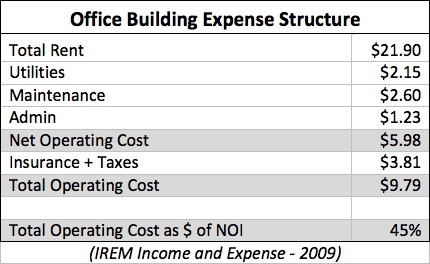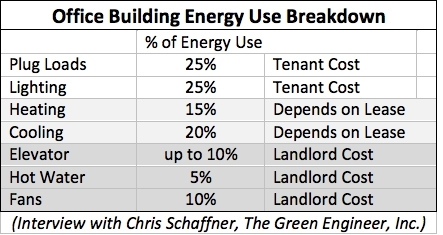Energy use reduction is a key part of a general cost reduction and operational efficiency effort for building managers. You can be a hero for saving your organization money by implementing relatively easy energy reduction strategies. Energy reduction focused capital projects can also provide new levels of amenity to building users, potentially increasing user satisfaction and saving money at the same time.
Managing Office Building Operating Costs
The general ratios of operating cost categories to total operating cost and to Net Operating Income (NOI) for commercial real estate or Operating Ratios for owner occupied buildings are relatively stabile in most areas of the country. Total utilities, including electricity, chilled water, steam, and natural gas comprises approximately 25% of Total Operating Costs, according to the Institute of Real Estate Management (IREM). Facility managers can achieve operating cost reductions of 3% to 6% from energy use reduction projects. These levels are quite achievable with a combination of operational changes and modest equipment upgrades.


Heating and cooling in leased buildings are generally centralized, with the costs passed on to tenants through rent or as a utility pass through. A strategy that is gaining momentum in leased office buildings is for owners to make lighting and other visible energy-related upgrades to tenant spaces with the goal of reducing overall cost of occupancy for the tenants. The value of this strategy to building owners is the ability to increase rent to capture some of the tenants’ lower operating costs. Owner occupied buildings can also make use lowered operating costs as a route to building user satisfaction. This strategy is much easier to pursue if the facility manager is tracking energy and water use at a relatively detailed level, to document lower operating expenses and occupant satisfaction.
Energy-related upgrades can also provide some of the few options for facility managers to reduce building operation expenses in ways that do not affect building users’ experience. Office lighting upgrades can provide the two-sided benefit of increased user satisfaction and lower energy costs. On the other hand, some energy-related projects will be more or less hidden from the users and primarily pursued to reduce energy demand, such as chiller and fan-unit upgrades. Such projects may end up providing the building users with better temperature control, but this is not the primary goal of the upgrade. Operational changes such as reducing the hours of HVAC and lighting operation, and changing setback temperatures, which require very little expenditure (if any at all) do not directly affect user experience, but can produce large reductions in electricity loads. In general, working with the building operations team to reduce energy use can produce impressive reductions in load. While these kinds of actions do not require capital, they do require attention of the facility manager. Energy use tracking systems and training for operators may be key to pursuing this strategy over multiple years.
Energy Use Reduction Strategies
Facility managers have a number of potential strategies available to them to help reduce energy use in their buildings. Strategies range from no-cost activities undertaken by the building operations team to high-cost engineered capital projects. Here is a list of strategies that have proven useful over the last several years. Simple payback analyses for selected strategies are shown in the accompanying box.
No-Cost Strategies
These strategies should always be employed:
- Review building operations processes, such as temperature set points and system timing
- Change out lightbulbs
- Maintain filters
- Seal windows and doors
All Payback analyses below are based on a 240,000 sq. ft. example building. Cost and Savings data from building analysis by Retroficiency. (www.Retroficiency.com).
Energy reduction strategies come from personal experience, from “Analyzing Capital Allocation for Energy Efficiency Improvements by Commercial Real Estate Investment Managers”, Peterson and Gammill, MIT Center for Real Estate Masters Thesis, September 2009, and from simulated building analysis by Retroficiency.
Simple Payback Analysis of Selected No-Cost Strategies


Low-Cost Strategies
- Installing occupancy sensors
- Commissioning or re-commissioning the space or building
- Tuning up equipment
- Calibrating controls
- Reviewing and modifying cooling tower operation
- Minor equipment upgrades
Simple Payback Analysis of Selected Low-Cost Strategies



High-Cost Strategies
- Elevator upgrade or replacement
- Window replacement (Replacing selected areas of window should be done before equipment upgrades.)
- Office lighting upgrades, including occupancy sensors
- Bathroom fitting replacement
- Renewable energy installations
Simple Payback Analysis of Selected High-Cost Strategies



There are many cost effective ways available to facility managers to develop a list of energy use reduction strategies that are appropriate for a specific building. The pro-active manager should be prepared for building user negotiations by developing a list of strategies in all three categories, with a basic understanding of the potential operating cost effects, as well as the effect on user experience. By combining reductions in operating costs through energy efficiency with amenities that users perceive as both valuable and sophisticated, property managers can be ready to provide the building that users want with an operating cost that facility managers like.




